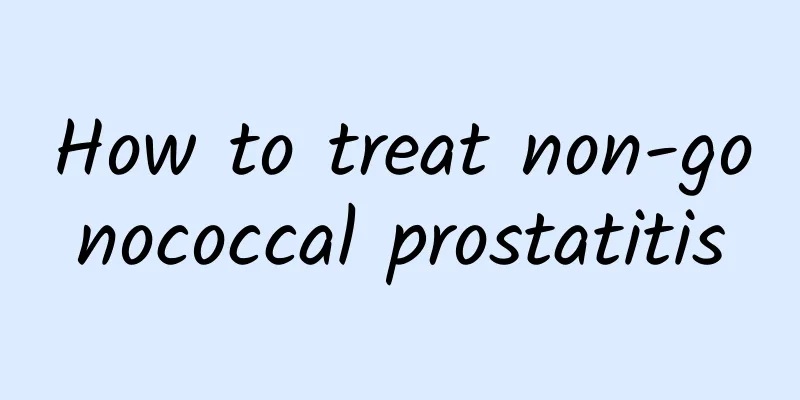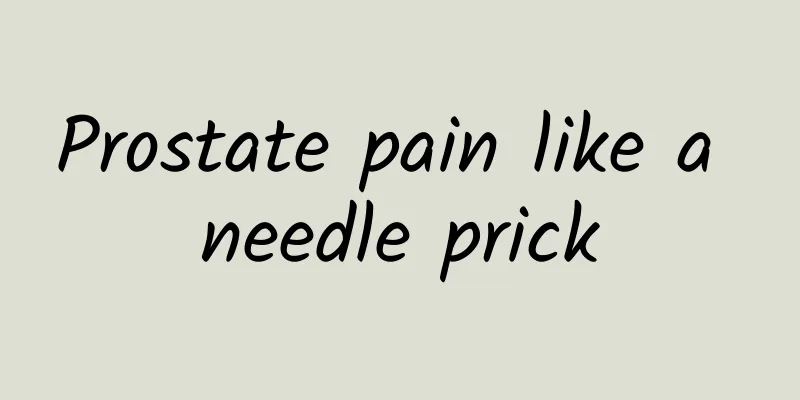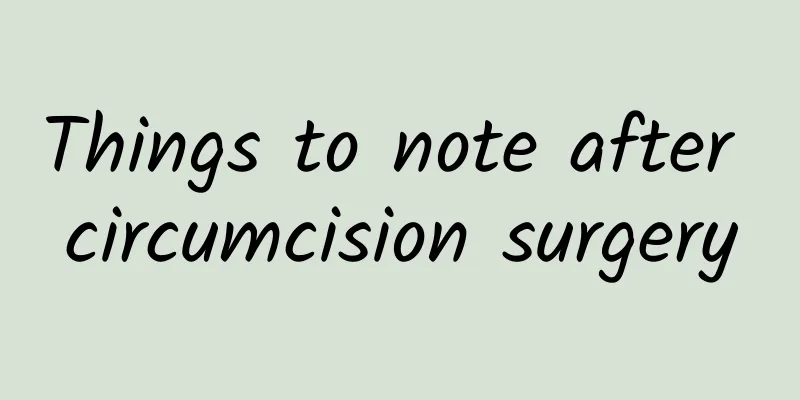How to treat non-gonococcal prostatitis

|
With the increase of social pressure, many young and middle-aged men are concerned about how to treat non-gonococcal prostatitis. This disease usually occurs because of anxiety, and life and work are often in a state of tension and fatigue. Male friends are the backbone of the family and the source of the economy. Once the body is unwell, they must go to the hospital for treatment. So how to treat non-gonococcal prostatitis? Let's see the introduction below. 1. Physical therapy Physical therapy mainly utilizes the thermal effect generated to cause congestion of deep tissues, improve blood circulation, enhance the nourishment of local tissues, accelerate the absorption and removal of inflammatory products, and facilitate the dissipation of inflammation. 2. Ultrasound therapy Ultrasound refers to vibration waves with a frequency of more than 20,000 cycles/second that cannot cause auditory response in normal people. The commonly used frequency in clinical practice is 800-1000 kilocycles/second. Medical ultrasound can improve local healing fluid and lymphatic circulation, strengthen local metabolism, change tissue acidity and alkalinity, change pH to alkaline, reduce local acidosis, and relieve or eliminate pain. Ultrasound treatment is suitable for patients with chronic prostatitis who have obvious urinary tract irritation symptoms and a large number of white blood cells in prostatic fluid microscopy. 3. Shortwave therapy It is a high-frequency current therapy. The current used is called short-wave current. The frequency is 3*10 6~3*10 7 Hz, the wavelength is 10~100 meters, and the voltage during treatment is 90~120 volts. The bactericidal effect of shortwave is not direct, but an indirect effect produced by shortwave enhancing the body's immune defense mechanism. Shortwave therapy is easy to operate. Two electrodes are used during treatment, one on the buttocks and the other on the pubic bone above the lower abdomen. Each treatment lasts 15~30 minutes, once a day, and a course of treatment is 2 weeks. This therapy is suitable for acute and chronic prostatitis and those with more white blood cells in prostate scopy. 4. Ultrashort wave therapy It is another method of treatment using high-frequency electric current. The frequency of the electric current is relatively high, generally 30~300 MHz, the wavelength is 10-1 meter, and the voltage during treatment is 40~50 volts. Its mechanism of action and adaptations are the same as those of shortwave therapy, but its ability to penetrate tissues and kill microorganisms is much greater than that of shortwave. 5. Microwave therapy It is a new high-frequency electrotherapy method. The frequency is 2450 MHz and the wavelength is 12.5 cm. It is easier to penetrate into the tissue than shortwave and ultrashortwave. It has a strong ability to kill microorganisms in deep tissues, and it will not overheat the subcutaneous tissue and the heat generated is uniform. The method of use is to put the microwave emitting probe into the rectum about 5 to 6 cm deep, and irradiate the prostate through the rectal wall. Each irradiation lasts 8 to 12 minutes, once a day or every other day, and a course of treatment is two weeks. Under normal dosage, microwaves are generally harmless to the human body, but the testicles are very sensitive to microwaves. Therefore, when treating prostatitis, care must be taken to protect the testicles from irradiation. People with infertility caused by prostatitis should be more careful when using this method. 6. Direct current drug ion introduction method It is a method of using direct current to diffuse drug ions into tissues through the skin or mucous membranes to achieve the purpose of treating diseases. The main route for drugs to enter the human body is through the openings of the skin and sweat gland ducts, and then gradually enter the blood and lymph; its treatment is the synergistic effect of direct current and drugs. Both Chinese and Western medicines can be introduced by ions, such as 1% streptomycin solution, 10% scutellaria solution, etc. Before the operation, the patient clears the stool, and the drug solution is poured into the rectum from the anus, and then direct current is applied, so that the drug components can penetrate into the rectum. Once a day, 20 minutes each time, two weeks as a course of treatment. This method is suitable for those with severe pain and obvious bladder irritation symptoms of chronic prostatitis. 7. Magnetic therapy This method uses magnetic field to treat the body to achieve the purpose of curing diseases. Experiments have shown that magnetic sheets with a magnetic field strength of 1500~3000 Gauss have a certain killing or inhibitory effect on E. coli and can increase local blood circulation, leading to the absorption and dissipation of exudates, and playing a role in reducing swelling and relieving pain. Generally, the magnetic sheet is attached to the skin surface near the prostate, such as the perineum point and Guanyuan point. This method is suitable for various types of chronic prostatitis. 8. Green Comprehensive Therapy The green light wave high energy treatment system treats classic prostatitis drugs through targeted penetration, achieving the three advantages of strong drug penetration, no antibacterial resistance, and repair of damage; oral kidney-benefiting drugs reach the lesions directly with the blood circulation, and have a comprehensive synergistic therapeutic effect on the prerenal sex glands and various complications; for severe cases, light magnetic field awakening therapy is used to induce meridian biological information, regulate balance, and enhance immunity; these three have no overlap in dosage form, method of use, or emphasis on efficacy. It is a highly targeted, complementary, multi-target, and highly efficient and synergistic treatment combination. 9. Non-thermal high frequency wave therapy The non-thermal high-frequency waves and periodic magnetic pulses with high penetrating power alternately penetrate the prostate, penetrate the lipid capsule of the outer layer of the prostate, and make the high-frequency energy reach the deep tissue, effectively improve the metabolism of cell tissue, improve the microcirculation system, and enhance the activity of local blood and lymphatic tissues and phagocytes and other immune systems, thereby achieving the effects of improving the body's immunity, repairing diseased tissues, improving microcirculation, anti-inflammatory, analgesic, and eliminating prostate hyperplasia 1 tissue. It has a more significant therapeutic effect on acute and chronic prostatitis, prostate hyperplasia (hypertrophy), urination obstruction, urethritis, sexual dysfunction and other diseases. The above is all about how to treat non-gonococcal prostatitis. I hope it can be helpful to male friends who are more concerned about this disease. Friends who suffer from the disease should not be anxious. If you are sick, you should seek treatment in time and actively cooperate with the treatment according to the doctor's instructions. I believe you will recover soon. |
<<: How to treat non-gonococcal urethritis prostatitis
Recommend
What are the treatments for prostatitis?
I believe everyone knows the importance of the pr...
What to do if you have prostatitis and thigh pain
The prostate disease is undoubtedly very harmful....
What is testicular dysplasia?
Testicular dysplasia is caused by heredity. An ex...
Guyuan Paste for Men
Nowadays, people pay more and more attention to h...
What should I do if the outside of my penis is itchy?
It is summer now, but many men still wear thicker...
How to treat male menopause?
We all know that women go through menopause, duri...
Zhang Yixing and Wu Shixun kiss, and we will take stock of the three benefits of kissing
Celebrities have always been the focus of people&...
Bleeding from abrasions on the glans penis
The glans penis is very sensitive. If there is ab...
Testicular congestion pain
The testicles are male reproductive organs and ar...
How to test whether the glans penis is sensitive?
Sexual nerve sensitivity varies from person to pe...
Will a 16-year-old boy still grow taller?
For parents, the growth and development of their ...
How to eat bullwhip to improve sexual performance? These three ways of eating are the most nutritious
For male friends, strong yang energy is also a sy...
Why does the foreskin of the glans penis hurt?
Male diseases have always been the most troubleso...
After ejaculation, the urethra is stinging. What is the problem?
If a male friend feels a stinging sensation at th...
Penis pictures
In daily life, most of our friends do not have a ...









